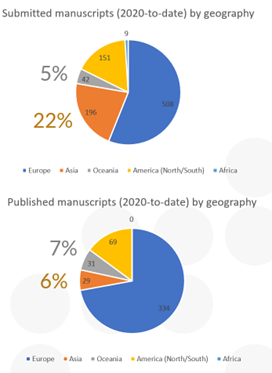EMA meets Asia 2024 Congress Report
The writing process – the perspective of the author
The first talk in this session was given by Ludvig Muren, editor-in-chief of ESTRO’s journal Physics and Imaging in Radiation Oncology (phiRO). Through this talk, Professor Muren addressed the publication process from the perspective of the author and gave advice on how to write a good scientific publication. Initially, Prof Muren used data from phiRO to show that there was a large variation in paper acceptance rates according to geographical region, which he attributed partly to writing skills. Scientific writing is a skill that can and should be practised continuously. Besides, beyond the writing process, scientific authors have clear responsibilities to adhere to all relevant ethics and data regulations. Prof Muren went through each and every element of a paper, from its title to its last reference and any supplementary materials. Critical parts, such as the identification of the ‘gap in the literature’ that the paper authors aim to fill, were given special attention, as were challenges in statistics, analysis and data presentation. Prof Muren ended by pointing out that the points from his talk had been integrated into a new author checklist that is available on the phiRO platform (https://legacyfileshare.elsevier.com/promis_misc/phro-authors-checklist.pdf).
.png.aspx?width=250&height=325)
Presenter: Prof Ludvig Muren, Aarhus University Hospital, Denmark.

phiRO’s data: Significant variation in paper acceptance rates is observed among different geographical regions
The reviewing process – the perspective of the reviewer and editor
Uulke van der Heide, section editor of the ESTRO journal Radiotherapy and Oncology, discussed what happens after the submission of a manuscript. Initially, the editor of the journal screens the manuscript to decide if it is within the scope of the journal and if the work is sufficiently novel to justify publication. If so, specialists in the field are invited to review the manuscript thoroughly. The reviewers again evaluate the novelty of the work as well as the general interest in the research topic. They focus on the correctness of the work: are the methods appropriate, are the statistics solid and do the conclusions match the findings of the research?
Reviewers send their recommendations to the editor, who then decides whether or not to publish. If the reviews are positive, authors typically are offered the opportunity to revise their manuscripts to remedy concerns that the reviewers may have raised. However, the process often results in a rejection to publish the manuscript. While this is obviously disappointing, the authors should not be discouraged. Rejections are part of the process and happen to both junior and experienced authors. Every submission and review process is a learning experience that will help to improve the quality next time.
For authors, it is important to follow the guidelines of the journal for submissions; for example, on the required sections in the paper and the numbers of figures and tables. In the ESTRO journals, the use of generative artificial intelligence is not prohibited in the text of the paper, but should be disclosed. Authors should be cautious nonetheless. Although chatbots can be useful to improve the quality of the English, the validity of statements is not ensured and requires careful scrutiny by the authors.
Presenter: Prof Uulke van der Heide, group leader, NKI, Amsterdam, and professor, Leiden University Medical Centre, The Netherlands.
